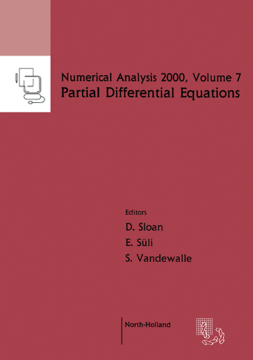
Additional Information
Book Details
Abstract
/homepage/sac/cam/na2000/index.html7-Volume Set now available at special set price !
Over the second half of the 20th century the subject area loosely referred to as numerical analysis of partial differential equations (PDEs) has undergone unprecedented development. At its practical end, the vigorous growth and steady diversification of the field were stimulated by the demand for accurate and reliable tools for computational modelling in physical sciences and engineering, and by the rapid development of computer hardware and architecture. At the more theoretical end, the analytical insight into the underlying stability and accuracy properties of computational algorithms for PDEs was deepened by building upon recent progress in mathematical analysis and in the theory of PDEs.
To embark on a comprehensive review of the field of numerical analysis of partial differential equations within a single volume of this journal would have been an impossible task. Indeed, the 16 contributions included here, by some of the foremost world authorities in the subject, represent only a small sample of the major developments. We hope that these articles will, nevertheless, provide the reader with a stimulating glimpse into this diverse, exciting and important field.
The opening paper by Thomée reviews the history of numerical analysis of PDEs, starting with the 1928 paper by Courant, Friedrichs and Lewy on the solution of problems of mathematical physics by means of finite differences. This excellent survey takes the reader through the development of finite differences for elliptic problems from the 1930s, and the intense study of finite differences for general initial value problems during the 1950s and 1960s. The formulation of the concept of stability is explored in the Lax equivalence theorem and the Kreiss matrix lemmas. Reference is made to the introduction of the finite element method by structural engineers, and a description is given of the subsequent development and mathematical analysis of the finite element method with piecewise polynomial approximating functions. The penultimate section of Thomée's survey deals with `other classes of approximation methods', and this covers methods such as collocation methods, spectral methods, finite volume methods and boundary integral methods. The final section is devoted to numerical linear algebra for elliptic problems.
The next three papers, by Bialecki and Fairweather, Hesthaven and Gottlieb and Dahmen, describe, respectively, spline collocation methods, spectral methods and wavelet methods. The work by Bialecki and Fairweather is a comprehensive overview of orthogonal spline collocation from its first appearance to the latest mathematical developments and applications. The emphasis throughout is on problems in two space dimensions. The paper by Hesthaven and Gottlieb presents a review of Fourier and Chebyshev pseudospectral methods for the solution of hyperbolic PDEs. Particular emphasis is placed on the treatment of boundaries, stability of time discretisations, treatment of non-smooth solutions and multidomain techniques. The paper gives a clear view of the advances that have been made over the last decade in solving hyperbolic problems by means of spectral methods, but it shows that many critical issues remain open. The paper by Dahmen reviews the recent rapid growth in the use of wavelet methods for PDEs. The author focuses on the use of adaptivity, where significant successes have recently been achieved. He describes the potential weaknesses of wavelet methods as well as the perceived strengths, thus giving a balanced view that should encourage the study of wavelet methods.
